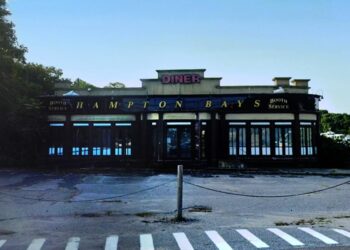Five years ago, the Parrish Art Museum moved from Jobs Lane in Southampton to its current location. In honor of its milestone anniversary at the Water Mill space, the Parrish is presenting Five and Forward: 5th Anniversary Weekend, three days of exciting, engaging activities.
We caught up with Director Terrie Sultan to learn more:
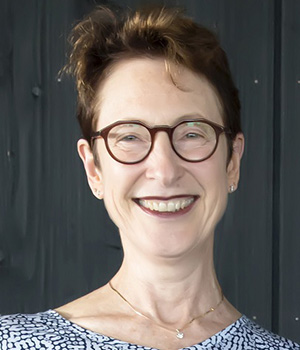 |
|
Director Terrie Sultan. (Photo: Daniel Gonzalez) |
How has the Museum changed since moving to the Water Mill location?
TS: Of course from Jobs Lane to Water Mill we increased our space from about 17,000 square feet to 34,000 square feet. We increased our exhibition space from 4,500 square feet to 12,500 square feet. The biggest change, which is the reason we moved forward with a big ambitious project like this, is now we can present temporary exhibitions, organized by curators with loans from other museums and collections, along with several galleries that are installed with works from our permanent collection. So that when we do a special exhibition, we can provide additional artistic and historical context by organizing many exhibitions within the galleries of the permanent collection that talks about other themes and concepts that are related to the temporary exhibitions that are on view, but it also allows us to work more closely with the school systems because now when we do an installation from the permanent collection, we generally leave it up for an entire year, meaning that the teachers, when they are developing lesson plans using works of art from the collection, there is an expectation and a knowledge that they will be here all year long for them. So they can build on their ideas and concepts. They can bring their students to the Museum over the course of time and still have those same pictures to talk about.
Why is it important for the Museum to provide educational outreach to the community?
TS: We really hope to be viewed as the center for cultural and community engagement on the East End of Long Island. Part of that, of course, is our recognition that we provide a service, which has to do with essentially putting people in proximity to conversation with ways of understanding and experiencing masterworks of art because one of the core values of our Museum that we believe very strongly is that art has the capacity to be life changing. Our education programs have to do with creative problem solving and visual literacy and narrative and history and all the things you need to be a well-rounded person and also to have the opportunity to just be in a welcoming environment where you can have a personal relationship with an artwork and an artist because we also do a lot of artist residencies where we’ll bring renowned artists into the Museum or into the schools, who will then work with the students and watching that sort of transformation happen is really something to see. It’s very important to us that we’re not just sitting here as a temple for art, but we’re a real place of engagement.
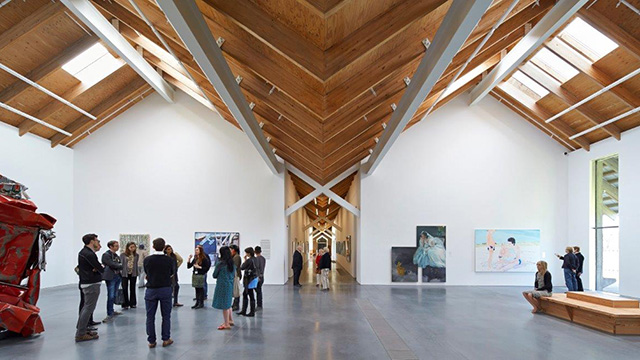 |
|
The Water Mill location opened in 2012. (Photo: Hufton + Crow) |
What are some of your most memorable moments from the past five years?
TS: I would say one very memorable moment was our first major artist-in-residence program here which we did with two brothers [William and Steven Ladd] that are a collaborative art making team. We did a special exhibition of their work and they came here for one month and did a collaborative art making event with 1,000 students. It was riveting. Those two young men are incredible. They were so engaged with these kids. They also worked with older kids, developmentally disabled, they worked with seniors. It was one of these dream projects that you can never really conceive of how amazing it’s going to be until it actually takes place.
Our John Graham exhibition, that we presented earlier this year in the summer, was life changing. There hasn’t been a major exhibition of that artist’s work in a museum in the United States for about 30 years. We did a lot of original research and one thing we did that we haven’t done before is that we actually did an illustrated historical timeline on the walls of the Museum that really made a connection with the visitors who stood in the galleries for 45 minutes and read the entire timeline and went and spent lots and lots of time in the Museum looking at the objects and all went to the Museum gift shop and bought the book. It was the highest selling book in the Parrish Museum’s history of publishing.
Well clearly the public liked the book.
TS: They did because it provided access. One of the things that is the most important about having moved into this building is that there’s so many new ways to provide access.
Your celebration weekend has a jam-packed lineup. Tell me a little bit about that.
TS: It’s interesting because it sort of mirrors what our weekend looked like when we opened the building five years ago. We had a full weekend of jam-packed events and we have another full weekend of jam-packed events. It’s quite intentional to serve various levels of our constitutions. The Friday night program is free with Museum admission or free if you’re a member. It will be a conversation about the Museum architecture and what it means to have a purpose built building – by that I mean a building that’s purpose is to really enhance and allow the core values of the Museum’s mission to be realized. Then on Saturday, we will have a special Members Reception. We have many, many members, celebrating the new installation of the collection and we’ve invited half a dozen artists who will be here that will each be speaking about a work of art in the collection that’s not their own. So, Bastienne Schmidt for example will be speaking about Alan Shields. It’s a way to encourage this kind of engagement. So if anybody wants to join before Saturday, they’re welcome to do that. Saturday night is a fundraiser – it’s a special celebratory cocktail party. The tickets are not terribly expensive, but it is a way for us to continue to do what we do. Sunday, from noon to 4 p.m., is a free Community Day. It’s full of all kinds of interactive activities.
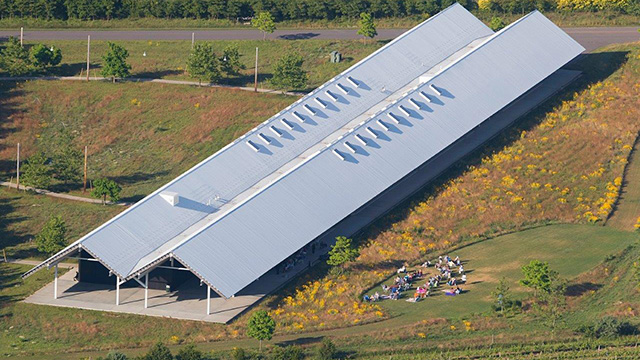 |
|
An aerial view of the Parrish. (Photo: Russell Munson) |
One of the things we really pride ourselves on here is there’s two different ways of engaging with people. One is participatory and the other is observational. Observation is you come, you sit down, you listen to a concert or you come, you sit down, and watch a movie. Which is very valid and we do that a lot. But participation is really what engagement is about, so on Sunday we have our bilingual tours in the galleries, we have several art making experiences – where people can come and work with artists and make collaborative works of art – but, we also have a couple of performances, one with a marimba band and another with this wonderful woman who plays music on a saw, which is really kind of amazing when you think about it. So we have all different kinds of ways of being in the Museum with different kinds of experiences all throughout the day.
You were just talking about membership, which I see starts at $40 per year, which is an absolute steal. What are some of the benefits of being a member?
TS: Certainly, the biggest benefit of being a member is free admission anytime. So if you’re planning on coming to the Museum, it’s $12 for admission. If you’re planning on coming six times a year, you need to be a member. If you go up the ladder with membership, there a special perks. There are special programs for upper level members. Upper level members are entitled to one of our free catalogues each year. As you go higher up with the levels, there are other kinds of events that are specifically for you – private tours of artists’ studios, intimate dinners with cultural people. People do join at high levels because they do want those extra perks, but most people join at the higher levels because they want to support the museum and support what we do.
What upcoming programming are you looking forward to?
TS: Well of course I always love our PechaKucha Nights. We do those four times a year. I call it cultural speed dating – they’re the most fascinating evenings. We invite nine or ten people in various fields. This is a very organized and prescribed way of doing this. It originated in Japan, which is why it’s called PechaKucha, which is Japanese for chitchat. Every presenter is allowed 20 images on a PowerPoint that’s on a timer for 20 seconds each, which gives each presenter 6 minutes and 40 seconds to talk about whatever they want to talk about. We’ve had artists, we’ve had farmers, we’ve had beer makers, we’ve had musicians, we’ve had fashion designers, we’ve had architects, and we have a curator that organizes this so it’s always a very broad based presentation for a couple of hours. Most of the people that come don’t know each other before they meet, so not only does everybody get to learn about everybody else, but they also get to meet and talk to each other and share their stories. It’s quite fabulous. I’ve certainly learned a lot in the seven or eight years that we’ve been doing this. It’s amazing how many talented people there are out here in all the different areas and some of them are really, really just fascinating speakers.
And that event typically sells out.
TS: Absolutely and that’s another reason to be a member because members get first crack at events like this.
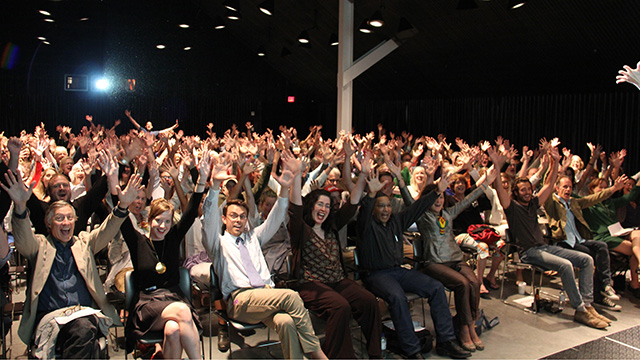 |
|
PechaKucha typically sells out. (Photo: Catherine Michelle Bartlett) |
The other thing that we do is every spring and fall we do our Salon Series piano concerts. We just finished our October one, so I’ll be looking forward to April in 2018 for our next four concerts. That’s always very talented younger musicians, mostly pianists, but not always, with innovative programs and classics in our theater, which is a wonderful venue for hearing classical music.
I’m very pleased and excited for people to come and see the newest iteration of our collection installation because it’s all new, we have a lot of pieces that are new to the collection that people haven’t seen, but also, many things that have been in the collection but haven’t been seen before, and various themes that we hope will be exciting and illuminating to people.
I’m excited about everything. There’s nothing this Museum does that doesn’t excite me. I love it here.
Where do you see the Museum in five years?
TS: I see the Museum in five years as having totally solidified our position as a center for cultural engagement on the East End with expanded opportunities for engagement, especially as it relates to art residences and other opportunities for our people to be in contact with our makers. That’s very important to us as we continue to build this program, that’s certainly one of our goals. I would like to see us in five years finish the last little bit of our capital campaign so that we can finish off our mortgage and start stockpiling some money in an endowment so we can have a little bit more financial stability, which of course is the goal of every non-profit in the history of the world, and sometimes obtainable and sometimes much more of a challenge. I see us continuing to be a place where young people can start their career and build into a museum profession and we are increasingly embedded in the lives of our students, which I also think is incredibly important.
Is there anything else you would like to add?
TS: This past five years seems to have happened in the blink of an eye. So, so many things that we said we wanted to do when we opened the doors on November 11 of 2012, many of which we have accomplished, and there are many more that we will be tackling in the next five years.
Parrish Art Museum is located at 279 Montauk Highway in Water Mill. For more information, call 631-283-2118 or visit parrishart.org.



